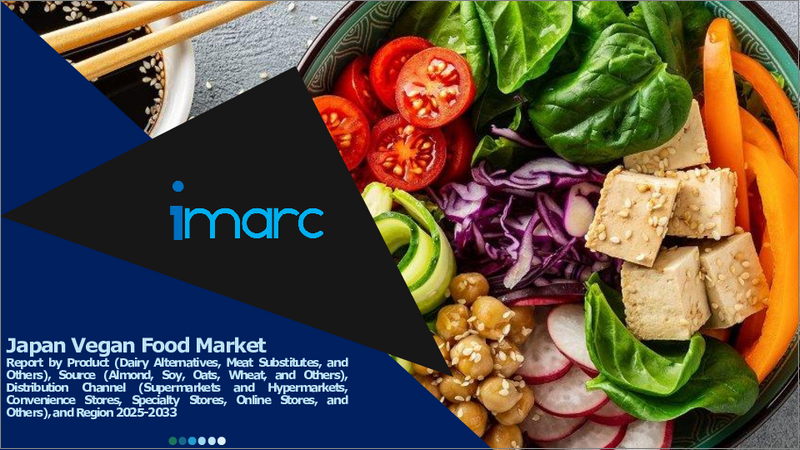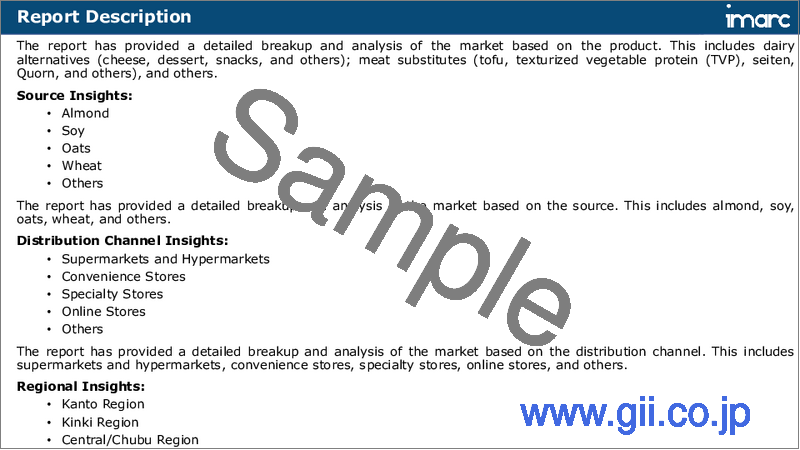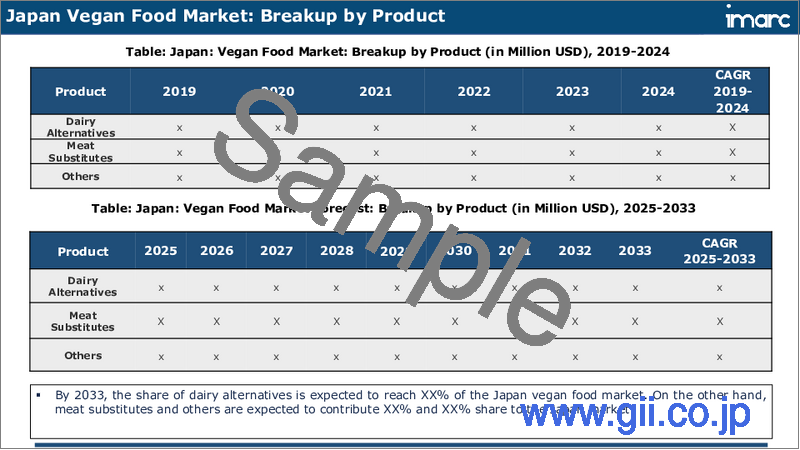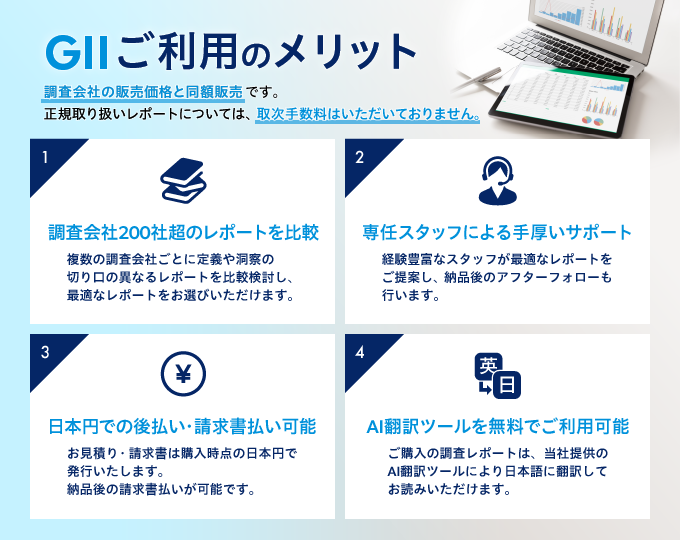|
|
市場調査レポート
商品コード
1609825
日本のヴィーガン食品市場レポート:製品、原料、流通チャネル、地域別、2025年~2033年Japan Vegan Food Market Report by Product, Source, Distribution Channel, and Region 2025-2033 |
||||||
カスタマイズ可能
|
|||||||
| 日本のヴィーガン食品市場レポート:製品、原料、流通チャネル、地域別、2025年~2033年 |
|
出版日: 2024年12月05日
発行: IMARC
ページ情報: 英文 119 Pages
納期: 5~7営業日
|
全表示
- 概要
- 目次
日本のヴィーガン食品市場の市場規模は2024年に12億米ドルに達しました。今後、IMARC Groupは、市場は2033年までに27億米ドルに達し、2025年から2033年にかけて9.7%の成長率(CAGR)を示すと予測しています。ヴィーガン食の採用の増加、革新的製品の導入、レストラン、カフェ、スーパーマーケットでの多様な食の選択肢の利用可能性、有名人やソーシャルメディアの影響力の増大は、市場を牽引する主な要因のいくつかを表しています。
本レポートで扱う主な質問
- 日本のヴィーガン食品市場はこれまでどのように推移し、今後どのように推移するのか?
- COVID-19が日本のヴィーガン食品市場に与えた影響は?
- 日本のヴィーガン食品市場の製品別の内訳は?
- 日本のヴィーガン食品市場の原料別の内訳は?
- 日本のヴィーガン食品市場の流通チャネル別の内訳は?
- 日本のヴィーガン食品市場のバリューチェーンにはどのような段階がありますか?
- 日本のヴィーガン食品市場の主な促進要因と課題は何か?
- 日本のヴィーガン食品市場の構造と主要プレーヤーは?
- 日本のヴィーガン食品市場の競合の程度は?
目次
第1章 序文
第2章 調査範囲と調査手法
- 調査の目的
- ステークホルダー
- データソース
- 市場推定
- 調査手法
第3章 エグゼクティブサマリー
第4章 日本のヴィーガン食品市場:イントロダクション
- 概要
- 市場力学
- 業界動向
- 競合情報
第5章 日本のヴィーガン食品市場情勢
- 過去および現在の市場動向(2019年~2024年)
- 市場予測(2025-2033)
第6章 日本のヴィーガン食品市場:製品別の内訳
- 乳製品の代替品
- 肉の代替品
- その他
第7章 日本のヴィーガン食品市場:原料別の内訳
- アーモンド
- 大豆
- オート麦
- 小麦
- その他
第8章 日本のヴィーガン食品市場:流通チャネル別の内訳
- スーパーマーケットとハイパーマーケット
- コンビニエンスストア
- 専門店
- オンラインストア
- その他
第9章 日本のヴィーガン食品市場:競合情勢
- 概要
- 市場構造
- 市場プレーヤーのポジショニング
- 主要成功戦略
- 競合ダッシュボード
- 企業評価象限
第10章 主要企業のプロファイル
第11章 日本のヴィーガン食品市場- 業界分析
- 促進要因・抑制要因・機会
- ポーターのファイブフォース分析
- バリューチェーン分析
第12章 付録
The Japan vegan food market size reached USD 1.2 Billion in 2024. Looking forward, IMARC Group expects the market to reach USD 2.7 Billion by 2033, exhibiting a growth rate (CAGR) of 9.7% during 2025-2033. The increasing adoption of vegan diets, the introduction of innovative products, the availability of a variety of food options in restaurants, cafes, and supermarkets and the growing influence of celebrity and social media influence represent some of the key factors driving the market.
Vegan food refers to food items and dishes that are entirely plant-based and do not include any animal-derived ingredients. Veganism is a dietary and lifestyle choice that excludes all animal products, including meat, poultry, seafood, dairy, eggs, and other animal-derived substances such as honey. These items are sourced from plant-based ingredients, which include fruits, vegetables, grains, legumes, nuts, seeds, and plant-based alternatives to traditional animal products. Vegan food options have expanded significantly in recent years, with the development of plant-based alternatives to traditional animal products. Vegan food can be prepared in a wide variety of dishes, ranging from salads, soups, and sandwiches to pasta, curries, and desserts. As veganism gains popularity, there is a growing emphasis on creating flavorful and nutritious plant-based meals that cater to a diverse range of tastes and dietary preferences. As a result, Japan vegan food market is experiencing significant growth, driven by a combination of factors that reflect changing consumer preferences, health consciousness, ethical considerations, and sustainability concerns.
Japan Vegan Food Market Trends:
A growing awareness of health and wellness is a key driver of the vegan food market in Japan. Consumers are increasingly seeking healthier dietary options to improve their well-being and prevent lifestyle-related health issues. Plant-based diets, rich in fruits, vegetables, whole grains, and legumes, are associated with various health benefits, including reduced risk of chronic diseases, improved digestion, and weight management. In addition, consumers in Japan are becoming more conscious of the ethical and environmental implications of their food choices. The negative impacts of animal agriculture on animal welfare and the environment are prompting many individuals to adopt vegan diets to reduce their carbon footprint and contribute to more sustainable food systems. Besides, the concept of flexitarianism, which involves reducing meat consumption while incorporating more plant-based foods into the diet, is gaining traction in Japan. As individuals seek a balance between health, taste, and environmental considerations, they are embracing plant-based foods to reduce their overall meat consumption. Moreover, the availability of a wider variety of vegan food options in restaurants, cafes, and supermarkets is driving consumer interest and adoption. Restaurants and food establishments are increasingly offering plant-based menus or vegan alternatives, making it easier for individuals to choose vegan options while dining out, representing another growth-inducing factor. Furthermore, influencers, celebrities, and health advocates who promote vegan diets on social media and other platforms have contributed to raising awareness and driving interest in vegan food. Their endorsements and personal experiences inspire others to explore plant-based eating, contributing to the market's growth across the country.
Japan Vegan Food Market Segmentation:
Product Insights:
- Dairy Alternatives
- Cheese
- Dessert
- Snacks
- Others
- Meat Substitutes
- Tofu
- Texturized Vegetable Protein (TVP)
- Seiten
- Quorn
- Others
- Others
Source Insights:
- Almond
- Soy
- Oats
- Wheat
- Others
Distribution Channel Insights:
- Supermarkets and Hypermarkets
- Convenience Stores
- Specialty Stores
- Online Stores
- Others
Competitive Landscape:
- The report has also provided a comprehensive analysis of the competitive landscape in the market. Competitive analysis such as market structure, key player positioning, top winning strategies, competitive dashboard, and company evaluation quadrant has been covered in the report. Also, detailed profiles of all major companies have been provided.
Key Questions Answered in This Report:
- How has the Japan vegan food market performed so far and how will it perform in the coming years?
- What has been the impact of COVID-19 on the Japan vegan food market?
- What is the breakup of the Japan vegan food market on the basis of product?
- What is the breakup of the Japan vegan food market on the basis of source?
- What is the breakup of the Japan vegan food market on the basis of distribution channel?
- What are the various stages in the value chain of the Japan vegan food market?
- What are the key driving factors and challenges in the Japan vegan food market?
- What is the structure of the Japan vegan food market and who are the key players?
- What is the degree of competition in the Japan vegan food market?
Table of Contents
1 Preface
2 Scope and Methodology
- 2.1 Objectives of the Study
- 2.2 Stakeholders
- 2.3 Data Sources
- 2.3.1 Primary Sources
- 2.3.2 Secondary Sources
- 2.4 Market Estimation
- 2.4.1 Bottom-Up Approach
- 2.4.2 Top-Down Approach
- 2.5 Forecasting Methodology
3 Executive Summary
4 Japan Vegan Food Market - Introduction
- 4.1 Overview
- 4.2 Market Dynamics
- 4.3 Industry Trends
- 4.4 Competitive Intelligence
5 Japan Vegan Food Market Landscape
- 5.1 Historical and Current Market Trends (2019-2024)
- 5.2 Market Forecast (2025-2033)
6 Japan Vegan Food Market - Breakup by Product
- 6.1 Dairy Alternatives
- 6.1.1 Overview
- 6.1.2 Historical and Current Market Trends (2019-2024)
- 6.1.3 Market Segmentation
- 6.1.3.1 Cheese
- 6.1.3.2 Desserts
- 6.1.3.3 Snacks
- 6.1.3.4 Others
- 6.1.4 Market Forecast (2025-2033)
- 6.2 Meat Substitutes
- 6.2.1 Overview
- 6.2.2 Historical and Current Market Trends (2019-2024)
- 6.2.3 Market Segmentation
- 6.2.3.1 Tofu
- 6.2.3.2 Texturized Vegetable Protein (TVP)
- 6.2.3.3 Seiten
- 6.2.3.4 Quorn
- 6.2.3.5 Others
- 6.2.4 Market Forecast (2025-2033)
- 6.3 Others
- 6.3.1 Historical and Current Market Trends (2019-2024)
- 6.3.2 Market Forecast (2025-2033)
7 Japan Vegan Food Market - Breakup by Source
- 7.1 Almond
- 7.1.1 Overview
- 7.1.2 Historical and Current Market Trends (2019-2024)
- 7.1.3 Market Forecast (2025-2033)
- 7.2 Soy
- 7.2.1 Overview
- 7.2.2 Historical and Current Market Trends (2019-2024)
- 7.2.3 Market Forecast (2025-2033)
- 7.3 Oats
- 7.3.1 Overview
- 7.3.2 Historical and Current Market Trends (2019-2024)
- 7.3.3 Market Forecast (2025-2033)
- 7.4 Wheat
- 7.4.1 Overview
- 7.4.2 Historical and Current Market Trends (2019-2024)
- 7.4.3 Market Forecast (2025-2033)
- 7.5 Others
- 7.5.1 Historical and Current Market Trends (2019-2024)
- 7.5.2 Market Forecast (2025-2033)
8 Japan Vegan Food Market - Breakup by Distribution Channel
- 8.1 Supermarkets and Hypermarkets
- 8.1.1 Overview
- 8.1.2 Historical and Current Market Trends (2019-2024)
- 8.1.3 Market Forecast (2025-2033)
- 8.2 Convenience Stores
- 8.2.1 Overview
- 8.2.2 Historical and Current Market Trends (2019-2024)
- 8.2.3 Market Forecast (2025-2033)
- 8.3 Specialty Stores
- 8.3.1 Overview
- 8.3.2 Historical and Current Market Trends (2019-2024)
- 8.3.3 Market Forecast (2025-2033)
- 8.4 Online Stores
- 8.4.1 Overview
- 8.4.2 Historical and Current Market Trends (2019-2024)
- 8.4.3 Market Forecast (2025-2033)
- 8.5 Others
- 8.5.1 Historical and Current Market Trends (2019-2024)
- 8.5.2 Market Forecast (2025-2033)
9 Japan Vegan Food Market - Competitive Landscape
- 9.1 Overview
- 9.2 Market Structure
- 9.3 Market Player Positioning
- 9.4 Top Winning Strategies
- 9.5 Competitive Dashboard
- 9.6 Company Evaluation Quadrant
10 Profiles of Key Players
- 10.1 Company A
- 10.1.1 Business Overview
- 10.1.2 Product Portfolio
- 10.1.3 Business Strategies
- 10.1.4 SWOT Analysis
- 10.1.5 Major News and Events
- 10.2 Company B
- 10.2.1 Business Overview
- 10.2.2 Product Portfolio
- 10.2.3 Business Strategies
- 10.2.4 SWOT Analysis
- 10.2.5 Major News and Events
- 10.3 Company C
- 10.3.1 Business Overview
- 10.3.2 Product Portfolio
- 10.3.3 Business Strategies
- 10.3.4 SWOT Analysis
- 10.3.5 Major News and Events
- 10.4 Company D
- 10.4.1 Business Overview
- 10.4.2 Product Portfolio
- 10.4.3 Business Strategies
- 10.4.4 SWOT Analysis
- 10.4.5 Major News and Events
- 10.5 Company E
- 10.5.1 Business Overview
- 10.5.2 Product Portfolio
- 10.5.3 Business Strategies
- 10.5.4 SWOT Analysis
- 10.5.5 Major News and Events
11 Japan Vegan Food Market - Industry Analysis
- 11.1 Drivers, Restraints, and Opportunities
- 11.1.1 Overview
- 11.1.2 Drivers
- 11.1.3 Restraints
- 11.1.4 Opportunities
- 11.2 Porters Five Forces Analysis
- 11.2.1 Overview
- 11.2.2 Bargaining Power of Buyers
- 11.2.3 Bargaining Power of Suppliers
- 11.2.4 Degree of Competition
- 11.2.5 Threat of New Entrants
- 11.2.6 Threat of Substitutes
- 11.3 Value Chain Analysis






